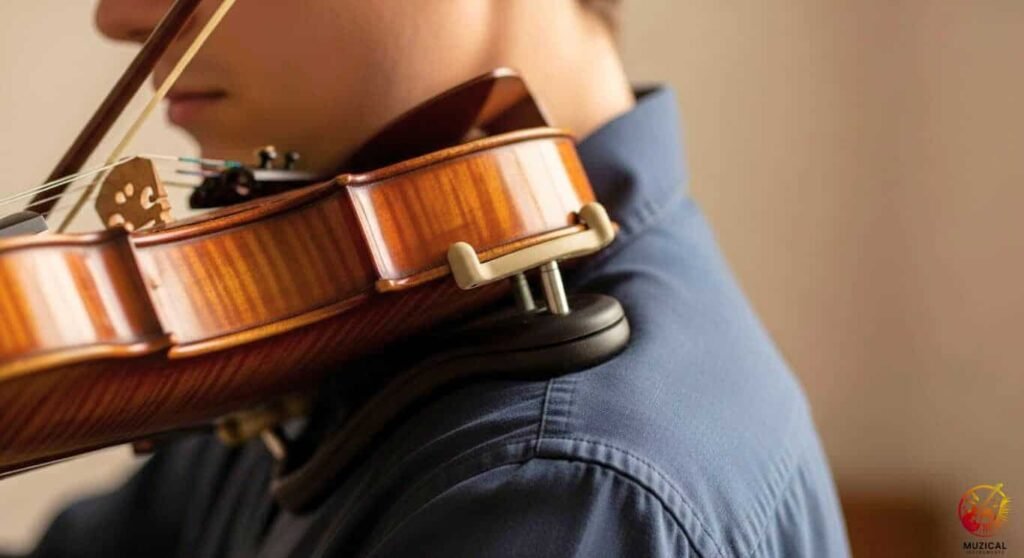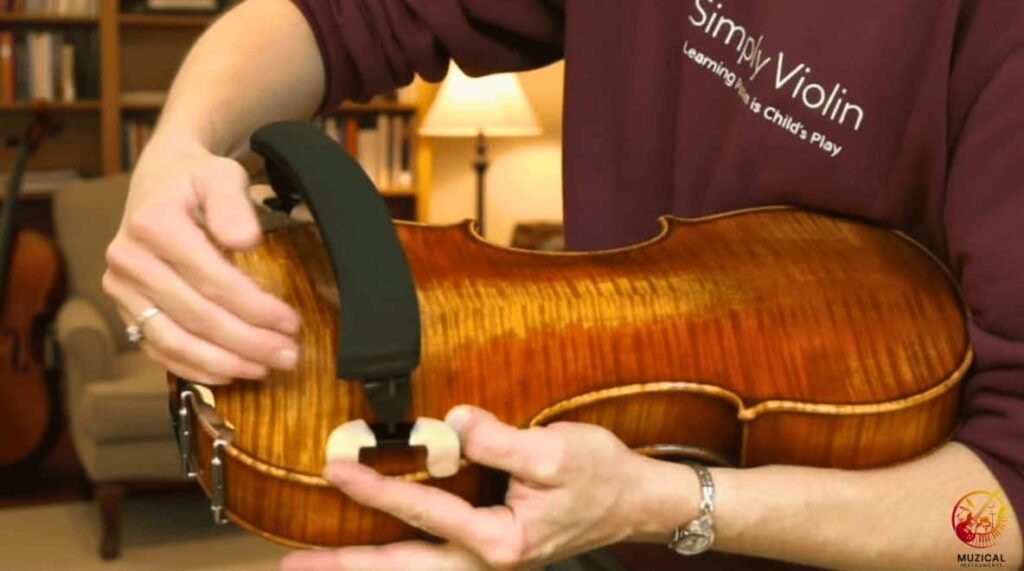How Should a Violin Shoulder Rest Fit? A Complete Setup Guide
How should a violin shoulder rest fit? It should sit firmly between your collarbone and shoulder without sliding, support the violin’s weight evenly, and let you hold the instrument without tension.
Most beginners struggle with this simple accessory because violin shops rarely explain proper adjustment.
In this article I’m going to give you the complete violin shoulder rest guide to get the correct violin shoulder rest setup. No more guessing.
What Is a Shoulder Rest Even For?

A shoulder rest sits between the back of your violin and your shoulder or collarbone. It helps support the instrument so you don’t have to squeeze it with your shoulder or tilt your head awkwardly.
Its main jobs are:
- To fill that empty space so you don’t have to shrug your shoulder up.
- To add a bit of grip so the violin doesn’t slide down your chest.
- To help you maintain a good, straight violin posture without tension.
A good fit means the violin feels secure, and your left hand and shoulder feel free.
The 3 Goals of a Perfect Fit
Before we start twisting knobs, you need to know what we’re aiming for. When you get this right, you’ll know.
- Stability: The violin shouldn’t slip or slide. You shouldn’t feel like you have to “catch” it.
- Comfort: No pinching, no digging, no red marks on your neck or collarbone.
- Freedom: Your left shoulder joint must be relaxed and down. Your left hand needs to be totally free to move up and down the fingerboard (this is called shifting) and to wiggle for vibrato.
If your neck is clamped, you can’t do any of those things well.
How Should a Violin Shoulder Rest Fit?: The 5-Step Guide

This is my step by step process. Do it in this order.
Step 1: Check Your Chin Rest (Yes, First!)
This is the mistake everyone makes. They buy a $50 shoulder rest and try to make it fit a $5 chin rest that doesn’t work for them.
Your chin rest is your anchor. The shoulder rest just supports the other end.
Your jaw should fit into the “cup” of the chin rest comfortably. If your chin rest is too small, too low, or pushes your head to the left, no shoulder rest will ever feel right.
Talk to a luthier (a violin maker) or your teacher about your chin rest first.
Step 2: Set the Width
Look at your shoulder rest. It has two “feet” or “brackets” that grab the edge of the violin.
- Where it goes: The feet clamp onto the lower bout (the fat part) of the violin.
- How wide: Adjust the feet so they are as wide as possible while still gripping the violin securely. Don’t put them so wide they are on the curved “C-bout” area.
- How tight: How tight should a violin shoulder rest be? Just snug. The rubber feet do the gripping. You don’t need to crank them on so hard you crack the wood. Just tight enough that it doesn’t pop off.
Step 3: Set the Height (The Most Important Part)
This is the big one.
- Put the shoulder rest on your violin.
- Put the violin on your body, with the rest sitting on your collarbone. (Not your shoulder joint… your collarbone. This is the correct violin shoulder rest position.)
- Let your head come down and place your jaw on the chin rest.
- Now, check the gap.
Your head should be in a natural, “looking straight ahead” position. You shouldn’t have to:
- Crank your neck down to reach the chin rest. (This means your rest is too low).
- Lift your chin up to get over the chin rest. (This means your rest is too high).
The violin, from the scroll to the endpin, should be almost parallel to the floor.
Step 4: Set the Angle and Tilt
This is the “ergonomics” part. Your body isn’t a flat block of wood. Your collarbone and chest have a slope.
Your shoulder rest needs to match that slope.
- Most rests (like a Kun) have feet that can tilt and swivel.
- The goal is to have the entire pad of the shoulder rest making even contact with your body.
- If only the front edge is touching, tilt it. If only the back edge is touching, tilt it the other way.
This small violin shoulder rest adjustment makes a huge difference in comfort and stops the violin from rocking.
Step 5: Test and Adjust (Over and Over)
You won’t get this right in 5 minutes. You need to play.
- Put the violin up. Play a simple G major scale.
- Does it slip when you cross strings?
- Now, without the violin, turn your head all the way left and all the way right. Feel that? That’s your range of motion.
- Put the violin up again. Turn your head left (toward the scroll). Does it pinch? Does it feel locked?
- Try shifting from 1st position to 3rd position. Does your whole shoulder shrug up?
Be patient. Make tiny adjustments. Turn one screw a quarter turn. Play for 5 minutes. See how it feels. This is an iterative process.
Common Beginner Mistakes (And How to Fix Them)

I see these every single day.
- The Hulk Grip: This is when you clamp down on the chin rest with all your might. Your neck goes stiff, and your jaw hurts.
- Symptom: You’re terrified of dropping the violin.
- Fix: Your shoulder rest is probably too low. Raise it up so it makes gentle contact. Trust your left hand to help support the violin’s neck.
- The Permanent Shrug: This is when your left shoulder is permanently lifted up toward your ear.
- Symptom: Your left shoulder aches after 10 minutes.
- Fix: Your shoulder rest is too high. It’s acting like a wedge, pushing your shoulder down and your violin up. Lower it until your shoulder can relax completely down.
- The Slippy Violin: The violin keeps sliding down your chest, and you have to “catch it” every few seconds.
- Symptom: You’re constantly re-adjusting the violin’s position.
- Fix: Your angle is wrong. The rest isn’t making full contact. Adjust the tilt (Step 4) so the pad grips your clothing/skin. Or, your rest might be too wide or too narrow (Step 2).
A Quick Look at Different Rest Types
Not all rests are built the same. Here’s a quick comparison.
| Rest Type | Example(s) | Best For… |
|---|---|---|
| Bar Rests (The “Standard”) | Kun, Wolf, Everest | Most beginners. They are simple, strong, and very adjustable for height and tilt. This is the best violin shoulder rest fit for beginners to start with. |
| Ergonomic Rests | Bonmusica, Mach One | People with long necks or sloping shoulders. These often have a “hook” or are made of bendable metal that can be shaped to exactly match your body. |
| Sponges & Pads | “AcoustaGrip,” simple sponges | Very young children (Suzuki method) or players who want just a little padding and grip, not structural support. |
My Final Checklist for a Good Fit
Still not sure? Run through this checklist. If you can say “yes” to all of these, you’re in a great place.
- Can you play for 15 minutes with no pain in your neck, shoulder, or jaw?
- Is your left shoulder relaxed and down while you play?
- Is the violin parallel to the floor (or pointing up just slightly)?
- Can you turn your head to the left and right without feeling pinched?
- Does the shoulder rest pad make full, even contact with your collarbone/chest?
- Does the violin feel stable when you shift or cross strings?
Finding out how a violin shoulder rest should fit is a journey, not a one time fix. Your body changes, and your playing improves.
The goal is to make the violin feel like a part of you. The correct setup, from your chin rest to your shoulder rest, is all about violin posture and shoulder rest working together.
Don’t be afraid to experiment. That tiny violin shoulder rest adjustment you’ve been avoiding might be the one that changes everything.
FAQ: How Should a Violin Shoulder Rest Fit?
1. How do you know if your shoulder rest is too high or too low?
It’s too high if your left shoulder has to shrug up to get on top of it. Your shoulder must stay relaxed and down. It’s too low if you have to bend your neck way down to reach the chin rest. Your head should stay mostly level and natural.
2. Should your shoulder be touching the shoulder rest?
No! This is the most common mistake. The rest doesn’t go on your shoulder joint (the part that moves). It goes on your collarbone and the area on your upper chest. Your shoulder joint must be totally free to move.
3. How tight should a violin shoulder rest be?
The feet should be just snug enough to grip the violin’s edges without popping off. Do not crank them on super tight! You could damage the wood. The rubber on the feet provides the grip, not extreme pressure.
4. Can you play the violin without a shoulder rest?
Yes, many professionals do! But it is very difficult for beginners. Playing without a rest requires a perfectly fitted chin rest and very strong, stable posture. For almost all students, using a shoulder rest is the best way to learn with good, relaxed posture.
5. What’s the difference between a chin rest and a shoulder rest?
This is so important!
The Chin Rest is the plastic or wood piece on the top of the violin where your jaw rests. This is your main anchor point.
The Shoulder Rest is the separate accessory that goes on the back of the violin. Its only job is to fill the gap between the violin and your collarbone.
